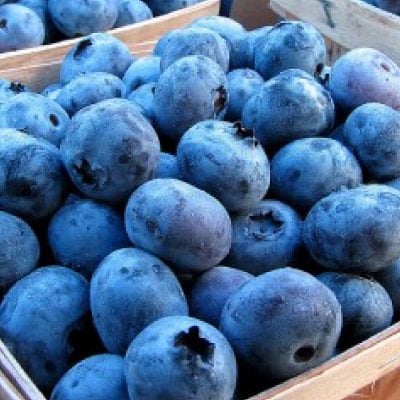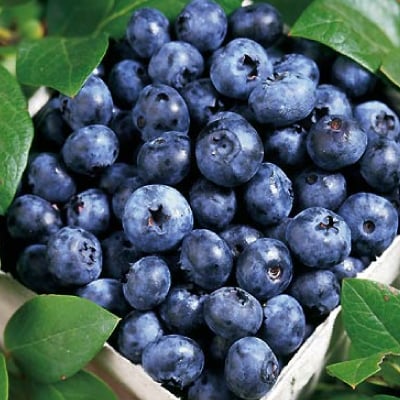
Learning Download: How to Grow Blueberries
From Seed to Harvest: A guide to growing blueberries.
Fresh blueberries are a summer staple in many gardener’s homes. Fresh blueberries can be used for jams, making muffins or eating raw.
To plant:
Plant blueberry bushes as early in the spring as possible. It is easiest to plant blueberry plants that are already 1 to 3 years old. Plant them in a sunny spot, although blueberries will tolerate some shade. Soil pH should be between 4 and 5, as blueberries thrive in acidic soil. Their root system is shallow, so be sure to plant in soil that holds moisture but also drains well. Plant the bushes in hols 20 inches deep and 18 inches wide. Set the bushes 5 feet apart in rows, and set the rows 8 feet apart. Prior to planting, prepare a mixture of two parts loam and one part peat moss, oak leaf mold, compost or aged sawdust to coat the bottom of the hole. When planting the bush, make sure its roots are spread out in the hole and then pack the hole tightly with soil. Blueberry bushes also can grow well in containers.
To grow:
Blueberries are popular amongst birds, so add a protective cage around the plants. Mulch the plants to keep the root systems moist and deter weeds. Blueberries require at least 1 to 2 inches of water per week. For newly set plants, younger than 3 years old, pinch back any blossoms that will develop into fruit because you do not want the plant to produce fruit in its first two years of life. Pruning will be required to stimulate blueberry growth after the plant’s first four years of life. Prune in the late winter or early spring. To do so, cut out dead, broken, short or weak shoots. For lowbush blueberries, cut all stems to ground level. Because pruned plants won’t bear fruit the season after pruning, it is suggested to only prune half a patch of blueberry plants at a time.
To harvest:
Harvest blueberries in late July or early August. Once berries turn blue, wait a few days and then pick them. When the berries are ready to pick, it shouldn’t be difficult to pull them from the stem. Blueberries freeze easily after harvest, and then they can be consumed for months.
What blueberries crave:
Apply fertilizer for the first time one month after planting, using 1/2 ounce of a 10-10-10 fertilizer applied about 6 inches from the crown of the plant.
One year after planting, apply 1 ounce of 10-10-10 fertilizer per blueberry bush in the spring around blooming time. Increase that rate by 1 ounce per year to a maximum of 8 ounces.
Where to buy blueberry plants:
You can find different varieties of blueberry plants at Urban Farmer.
Learning Download: Common pests and diseases: Blueberries
Common pests and diseases: Blueberries
When growing fruits and vegetables, it is always exciting to care for the plant throughout its growing phase and then harvest it for delicious recipes later on, but one thing to watch out for is pests and diseases. Different plants are susceptible to different types of pests and diseases, and it is important to make yourself aware so you can keep a watchful eye and also take any preventative methods to keep your plants safe throughout their lifespan.
Blueberries can fall victim to several different pests and diseases.
Pests:
Some of the most common pests affecting blueberries include mites, flea beetles and Japanese beetles.
Mites cause scales on the buds, misshapen flowers and poor growth and low yields. Mites are microscopic, which means they are hard to see, so be on the lookout for the symptoms. To manage or prevent this problem, apply miticides just after harvest.
Flea beetles leave small holes in the leaves and younger plants are more likely to be targeted. If a flea beetle infestation occurs, plant growth may decrease. The damage can even kill the plant if it is severe enough. To manage or prevent this problem, utilize floating row covers and apply a thick layer of mulch.
Japanese beetles leave skeletonized leaves, and they also affect the roots as well as growth above ground. The beetle’s larvae feed on the roots, and the adults feed on the leaves and fruits. Both larvae and adults cause damage. To prevent this problem, use insecticides.
Diseases:
Some of the most common diseaes affecting blueberries include mummy berry, powdery mildew, stem canker and more.
Mummy berry causes the plant’s new leaves and shoots to droop in the spring. It also will cause the upper portion of the shoots to turn brown rapidly, and the infected shoots can even die. The infected berries will be pink or white in appearance and then turn tan. The berries can become shriveled. To manage this, prevent only disease-free plants and also bury or remove the mummified fruit. Apply foliar fungicides if you are a commercial planter struggling with this issue.
Powdery mildew will cause a fluffy white growth on the upper or lower surfaces of the leaves. Leaves may look puckered, and they can develop chlorotic spots with red borders. To manage this disease, plant resistant, high-bush varieties and apply the appropriate foliar fungicides if they are available.
Stem canker will cause red lesions on green stems. The lesions then become swollen. Some varieties of blueberries are more susceptible, the cankers may kill the stem. To prevent this disease, be sure to plant resistant varieties. Also, do not use infected wood for propagation.


